The Sony A95L is a television that made a huge impression on us. Although it has been a year since its release, it still deserves a place among the best models on the market. When it comes to picture quality, it is simply brilliant. Deep blacks, intense colors, and excellent brightness in HDR make everything look incredibly realistic. The QD-OLED panel does its job – movies and games look so good that sometimes you forget it's just a screen. Using the A95L on a daily basis is a pleasure. Google TV works smoothly, and there are plenty of apps available. The package includes two remotes: one traditional and one backlit – a really useful solution, especially in the evenings. Additionally, there is a voice assistant that makes life easier by allowing quick searches for movies or controlling the home from the couch. Gamers will also be delighted. A refresh rate of 120 Hz, low input lag (below 10 ms even in Dolby Vision), and VRR support create a set that will satisfy any gaming fan. And the sound? The Acoustic Surface Audio+ system makes sound come directly from the screen, providing excellent, spatial experiences. Of course, there are no perfect things. Two HDMI 2.1 ports (one of which is for eARC) may be a bit insufficient if someone wants to connect a console, soundbar, and other devices. In a bright room, the black may have a slightly cherry tone, which may be bothersome for more demanding users. Despite these minor comments, the Sony A95L is a piece of excellent equipment. The picture, sound, and functionality are at the highest level. It is a television that will satisfy both cinema lovers and gamers, offering true premium experiences in the comfort of home.
- Matching (Score)
- Our verdict
- TV appearance
- Where to buy
- Contrast and black detail
- HDR effect quality
- Factory color reproduction
- Color reproduction after calibration
- Smoothness of tonal transitions
- Image scaling and smoothness of tonal transitions
- Blur and motion smoothness
- Console compatibility and gaming features
- Input lag
- Compatibility with PC
- Viewing angles
- TV efficiency during daytime
- Details about the matrix
- TV features
- Apps
- Playing files from USB
- Sound
Sony A95L vs LG OLED G5
Direct compare
Check the best price offer:
LG OLED G5A95L
G54 / G51 / G55 / LW / LS

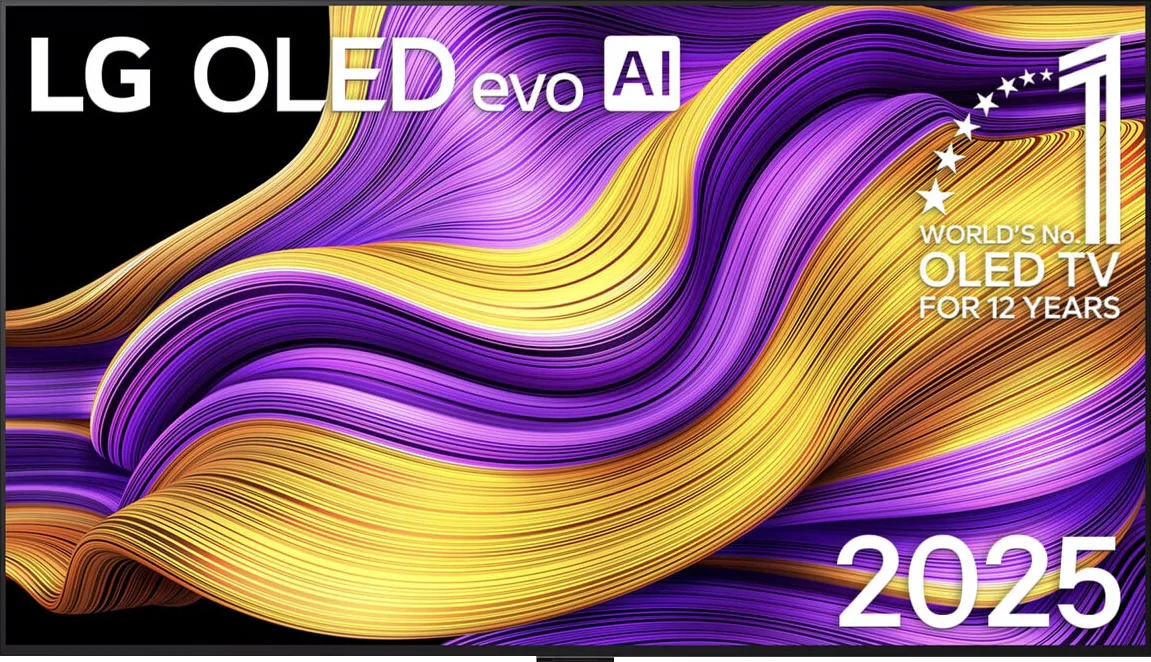
Panel type: QD-OLED
Resolution: 3840x2160
System: Google TV
Model year: 2023
Complete the survey to find out the result

Panel type: WRGB OLED
Resolution: 3840x2160
System: WebOS
Model year: 2025
Complete the survey to find out the result

Overall rating
8.3
8.9
Movies and series in UHD quality
9.0
9.2
Classic TV, YouTube
9.3
9.2
Sports broadcasts (TV and apps)
9.0
9.0
Gaming on console
9.3
9.6
TV as a computer monitor
5.0
8.8
Watching in bright light
5.4
8.0
Utility functions
8.8
8.5
Apps
9.6
9.1
Sound quality
7.9
8.7
Complete the survey to find out what fits your preferences
Advantages
Amazing Contrast
Great for HDR movies
Advanced Google TV system
Great Viewing Angles
Gaming Features: ALLM support, VRR, 120 Hz refresh rate, low input lag
Great sound
Camera included
Amazing black and contrast
Reference color reproduction after calibration
Very high brightness in HDR content
Outstanding cooperation with consoles and computers
Great motion fluidity - OLED panel 165Hz
Many features for gamers: VRR, ALLM, HGIG, low input lag
Excellent WebOS operating system with many applications
Superb handling thanks to the Magic remote with "cursor" function
Disadvantages
Only Two HDMI 2.1 Ports: One of the HDMI 2.1 ports is used for eARC, which may limit the number of devices that can be connected, especially for those using a soundbar and a console
Cherry black effect in bright light: The QD-OLED panel causes blacks to lose their depth in strong light
Not the sleekest design
Price compared to competitors
No support for DTS audio format
Worse (though still good) viewing angles than the predecessor G4
Different versions of the remote in derivative models – hard to predict which version we will get
Our verdict
The LG G5 is a television that not only continues but also expands on what we loved about previous models in the G series. Instead of taking the beaten path, LG opted for a new Tandem OLED panel – and it was a stroke of genius. Picture brightness? Simply, F E N O M E N A L. HDR effect? Close to reference. Colors after calibration? Nearly perfect. Motion smoothness, low latency, and gaming features? At an absolutely top level. The G5 performs well in movies and games, day and night, whether with a decoder, console, PC, or just the remote. Of course – this is not a product without flaws. It's a pity that DTS support is lacking, the viewing angles have worsened compared to its predecessor, and the remote may vary depending on the version. But when we look at the overall picture, it's hard not to feel that this is one of the best OLED televisions available on the market, and perhaps even the best. Definitely, when it comes to its versatility and picture quality without having to reach for extremely expensive models from competitors. If you're looking for a television for everything – for cinema, gaming, a bright living room, streaming content, or connecting a computer – the LG G5 is a device that simply delivers on every front without compromise.
TV appearance





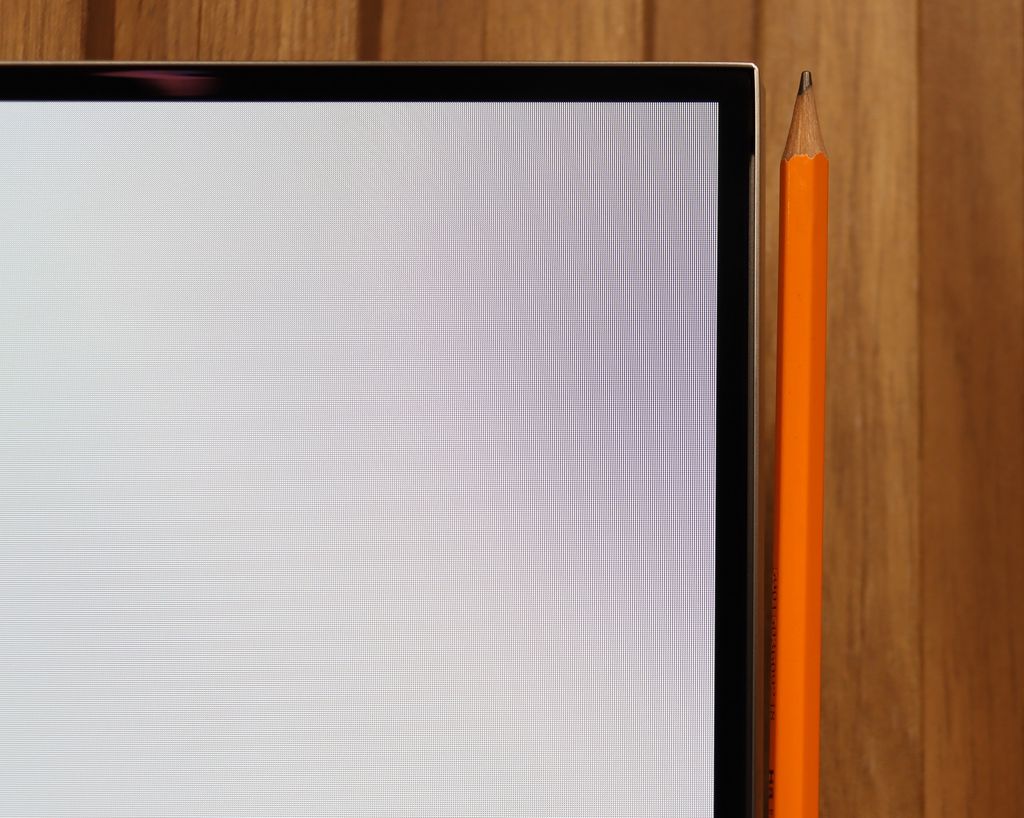
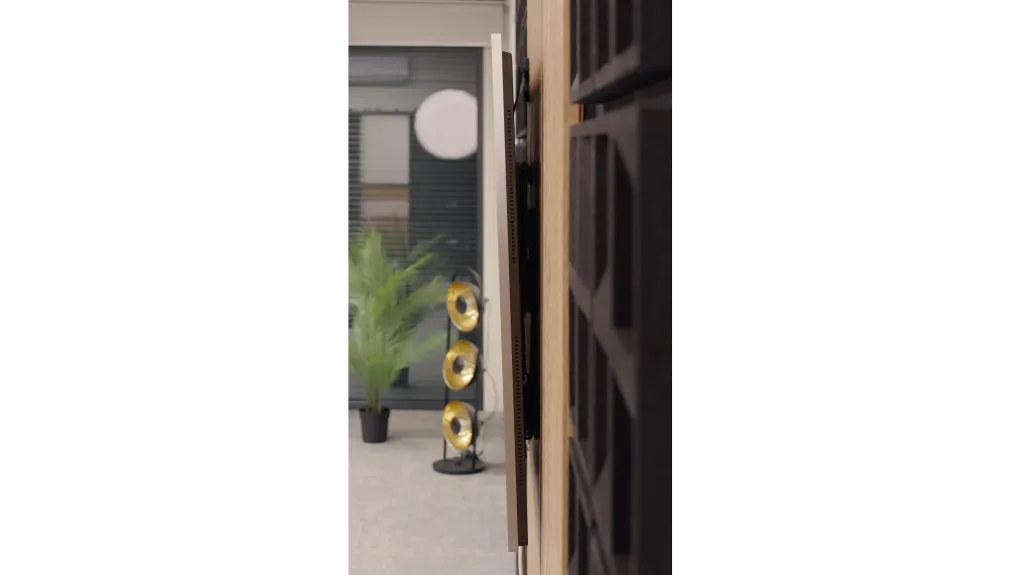
Contrast and black detail
10/10
10/10
Contrast:

Result
∞:1

Result
∞:1

Result
∞:1

Result
∞:1

Result
∞:1

Result
∞:1

Result
∞:1

Result
∞:1

Result
∞:1

Result
∞:1
Halo effect and black detail visibility:


Sony A95L is an OLED television that truly impresses when it comes to contrast. Thanks to OLED technology, this model offers perfectly deep blacks – in dark scenes, there are no discolorations or glow, which makes the images look incredibly realistic. Additionally, QD-OLED technology allows for achieving higher brightness, which further emphasizes the difference between light and dark elements. As a result, in scenes like those from the movies Oblivion or Sicario 2, A95L Sony effectively separates lights from shadows, enhancing the clarity and depth of the image – an ideal solution for those seeking cinematic experiences at home.
LG G5, as befitting an OLED television, impresses with its contrast and black quality. In scenes with a lot of dark areas, the screen looks almost perfect, offering deep, absolute black and infinite contrast – an effect that still cannot be achieved on any LCD television. The new Tandem OLED panel does not introduce any negative changes compared to previous generations – blacks are perfect regardless of the content. Watching scenes from movies like The Revenant or Oblivion, you can clearly see the excellent separation of lights, without any blooming effect or brightening of dark parts. In this category, the LG G5 deserves the highest rating.
HDR effect quality
7.8/10
9.1/10
Luminance measurements in HDR:

Result
1471 nit

Result
1498 nit

Result
1465 nit

Result
1527 nit

Result
626 nit

Result
2346 nit

Result
2353 nit

Result
2399 nit

Result
2353 nit

Result
2012 nit
Scene from the movie “Pan” (about 2800 nits)


Scene from the movie “Billy Lynn” (about 1100 nits)


Static HDR10


Dynamic: Dolby Vision
Dynamic: Dolby Vision


HDR luminance chart:
LG OLED G5
HDR luminance
Luminance of RGB colors
Sony A95L
HDR luminance
Sony A95L offers an incredible HDR effect, achieving an impressive brightness level of 1500 nits in scenes such as those from Life of Pi or Sicario 2. These results are truly remarkable – the bright elements in these films practically come to life on the screen, providing the viewer with immersive visual experiences. The only thing to note is minor issues with maintaining brightness in the scene from The Meg, where the entire scene is flooded with light. However, this is a natural effect related to OLED technology. The wide coverage of the BT.2020 color palette at 89% is also a significant advantage, placing A95L Sony among the top TVs in terms of color reproduction. All of this is made possible by the QD-OLED panel from Samsung Displays.
LG G5 with the new Tandem OLED panel brings the biggest change specifically in terms of the brightness of the television. And it’s quite impressive. This is truly an astronomically bright OLED. In every tested scene – whether it’s point lights or full-screen whites from the movie The Meg – the brightness on the G5 exceeded 2000 nits. Just a year ago, such values on an OLED were simply unimaginable. And here we are – the G5 comes close, and at times even surpasses the best Mini-LEDs on the market. A new feature of the Tandem OLED panel is the expanded color gamut coverage – and here the LG G5 performs almost perfectly. DCI-P3 achieves a full 100%, while BT.2020 maintains around 83%. These are some of the highest values currently available on the market – it’s hard to find any other television that comes close to such results, unless we are talking about the best displays with QD-OLED panels. The G5 has nearly reference-quality HDR – both in terms of brightness and color saturation. This is an OLED that can truly shine – and not just figuratively.
Factory color reproduction
7.9/10
7.8/10


Factory Mode
After calibration


Factory Mode
After calibration
The best factory mode in terms of color reproduction in Sony A95L is IMAX Enhanced. This is a mode that, at first glance, seems to be well calibrated; however, upon closer examination, several areas requiring improvement can be noticed. First and foremost, the white balance for both SDR and 4K HDR content is skewed with excessive blue and red color, leading to a subtle pink tint, particularly noticeable on neutral tones. As a result, skin tones are inaccurate, affecting the realism of the displayed image. This is clearly visible in the comparison photo below. Additionally, the Colour Checker test confirms the presence of these errors—color samples often deviate from their reference values, indicating some inaccuracies in the factory color reproduction of A95L Sony. The maximum deltaE error values reach up to 5.8, which is a clear indication that colors are not always reproduced as precisely as they should be.
Regarding brightness characteristics, the gamma for HD/SDR content is generally quite correct, maintaining an appropriate balance between brightness and contrast. Unfortunately, there is a significant jump at the end of the graph, leading to a strong brightening of the image when the screen is fully flooded with white. This can make scenes with very bright backgrounds, such as snowy landscapes or intense daylight, appear overly vivid and lose detail. In the case of HDR content, the EOTF curve, which is responsible for controlling luminance, is slightly boosted compared to the reference values. This, in turn, causes the image to be somewhat brighter than it should be, which may affect the perception of more subtle details in the darker areas of the frame.
Our test unit LG G5 struggled with some issues in the factory Filmmaker mode. And while the image might have seemed fine to most people, we knew that this TV was capable of much more. This mode had a clear excess blue tint in the white balance, resulting in a strong cooling of the image – particularly in HDR modes, where there was also a lack of red. The picture seemed cold, and its sharpness was artificially boosted and unnatural. Another significant issue was the brightness characteristic. In SDR content, the situation wasn't the worst, aside from a slight dimming of the entire image. However, it performed much worse in HDR materials – due to improper brightness management, the smallest details could completely disappear from the image, and larger, bright elements appeared overexposed and lacking gradation. Luckily, the G5 supports calibration using 3D LUT (a tool for professionals to calibrate colors), so we decided to take advantage of its professional background and see what it was really capable of. Because while it wasn't terrible even before calibration, the potential of this TV definitely deserved more.
Color reproduction after calibration
9.3/10
9.8/10




Sony A95L offers excellent tools for professional screen calibration, allowing you to maximize the capabilities of the IMAX Enhanced mode. We used them to bring the image to a level that will satisfy even the most demanding viewers. After calibration, the white balance for both 4K HDR and SDR content looks simply great – almost perfect. The Colour Checker test confirmed that deltaE errors do not exceed a value of "2", which means that color reproduction is extremely accurate, and any deviations are practically imperceptible to the human eye.
Calibration also brought a significant improvement in terms of brightness – gamma is now perfectly balanced, eliminating the previous issue of excessively brightening scenes with very bright backgrounds. As a result, even the most vibrant moments, such as snowy landscapes or intense daytime scenes, appear natural, without the effect of clipping. The EOTF curve, which is responsible for controlling luminance in HDR content, has also been improved – it now reaches a reference level, both in synthetic tests and in practical movie watching.
As a result of the calibration, A95L Sony offers excellent experiences, whether you're watching material from regular television or your favorite movies. Every detail is reproduced exactly as the creators intended – without unnecessary brightening, with perfectly rendered colors and appropriate depth. This shows that this television, after professional tuning, is capable of competing with the best screens on the market, offering an image that truly impresses.
After completing the calibration process using professional tools, we can confidently state that the LG G5 offers nearly reference-quality image. Most of the errors related to white balance and the ColorChecker test are below the value of 2, which is a phenomenal result, practically imperceptible to the human eye. And while one could still criticize that in HDR films the television tends to slightly dim the smallest elements of the image, in practice, this does not negatively affect the overall impression. Hats off to LG, because once again they provide the user with enormous possibilities for adjusting their display – and this, combined with very good parameters of the panel itself, results in an image that is truly hard to surpass.
Smoothness of tonal transitions
9/10
8.5/10












The fluidity of tonal transitions in A95L is truly remarkable – it is one of the greatest advantages of QD-OLED panels. The image appears extremely smooth, and all transitions between different shades are perfectly rendered, without noticeable jumps or distortions. As of today, it is hard to find a panel that better handles such precision in reproducing tonal transitions. Of course, if someone really looks closely, small errors can be seen in the areas of black, but they are subtle enough that hardly anyone will notice them during normal use of the Sony A95L. For most users, these minor imperfections will be completely unnoticeable, and the fluidity and detail of the tonal transitions will satisfy even the most demanding enthusiasts of excellent image quality.
The smoothness of tonal transitions in the LG G5 is a clear step forward compared to last year's model. Not only has the brightness improved, but also the way colors blend, which the G4 sometimes struggled with. In the vast majority of scenes, the G5 has no issues with tonal transitions – there is no typical banding associated with WOLED technology, nor ugly breaks between colors. Of course, in very dark areas of the image and with shades of gray, minor imperfections can still be noticed, but these are things that the average viewer wouldn't even register. In short – it's really good.
Image scaling and smoothness of tonal transitions
8/10
8.7/10
Smooth transition function

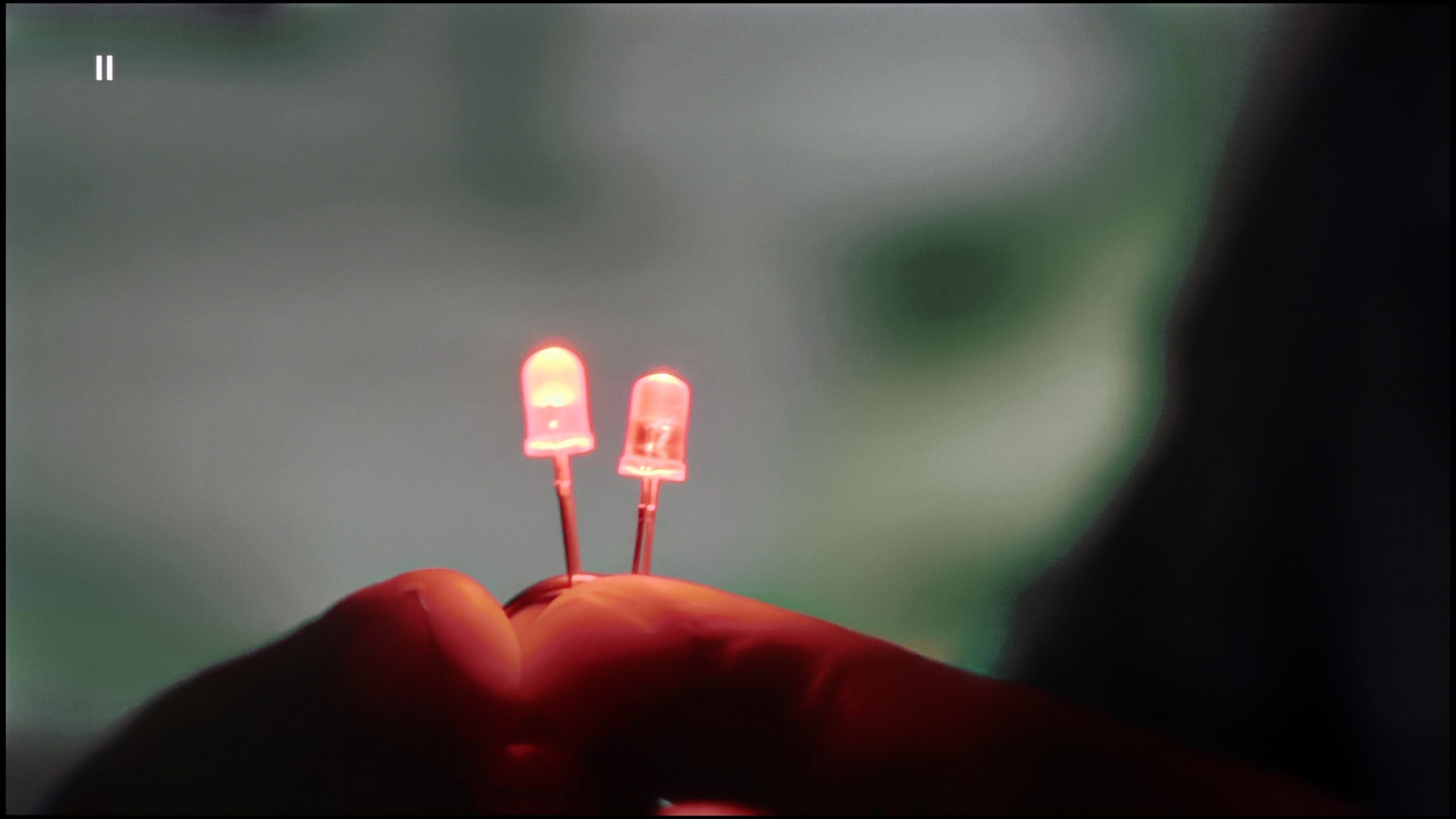
Image without overscan on the SD signal


The tonal transition smoothing function in Sony A95L works really well and is worth noting. We recommend setting it to the "Medium" level because at this value, you achieve an ideal compromise – there are no artifacts, and the image looks extremely natural and pleasant to the eye. This allows for smooth transitions between different shades while maintaining scene detail, which further enhances viewing comfort.
As for upscaling, you can see the full power of the XR processor here. Sony A95L handled our test material featuring a model excellently – the image is exceptionally clear, there are no excessive jagged edges, and the details in the background are perfectly preserved. The XR processor effectively improves low resolution, providing very good results that allow you to enjoy content in almost high quality, even if its source is not ideal.
Upscaling and digital image processing in the LG G5 perform very well. The television handles lower quality content exceptionally, especially when the "Smooth Gradation" feature is set to a low level. In this mode, it effectively removes unwanted artifacts and issues with visible tonal transitions. It may also slightly smooth out some desired details, such as the subtle texture of clothing or skin, but importantly – it does not remove film grain, so it’s hard to say there’s a serious compromise here. It’s one of those options that’s definitely worth enabling.
The G5 also does well with upscaling, which is improving the quality of older materials. The test image with the model looked really solid – slight edging was visible, but that’s an effect that can’t be completely avoided. Additionally, there were no issues with overscan, which – contrary to appearances – is not obvious, even in 2025.
Blur and motion smoothness
8.5/10
9/10

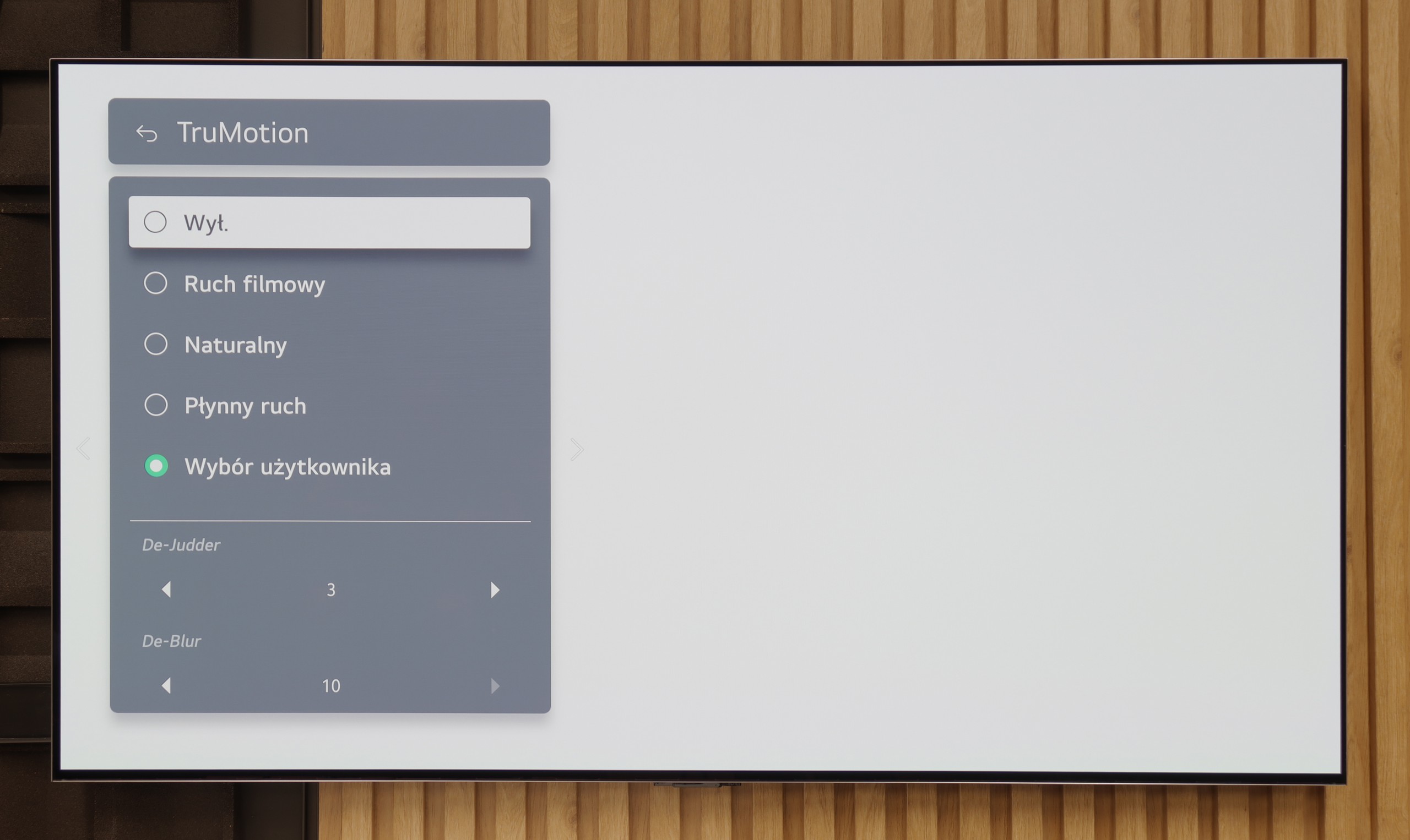
Blur (native resolution, maximum refresh rate):






Blur (BFI function enabled):



Image flickers in this mode



Smużenie ():
Smużenie (4K 165Hz):



Sony A95L is a TV that should satisfy both gamers and movie lovers. When it comes to watching movies, this model is equipped with Motionflow technology, which allows precise adjustment of whether we want the image to be more "framey," like in traditional cinema, or exceptionally smooth, like in cinema TVs. The "Smoothness" slider allows you to regulate the level of smoothness – from subtle changes to a more noticeable effect, while the "Clearness" slider is responsible for reducing flicker and artifacts, helping to achieve more natural and clearer motion. Regarding gaming and watching sports, the A95L Sony television offers a refresh rate of 120 Hz, making every dynamic action look incredibly smooth. Gamers will appreciate the lack of blur, while sports fans will see every movement in full sharpness. Overall, the TV performs great – both with fast-paced gaming and emotionally charged movie sequences.
The motion fluidity on the LG G5 is simply phenomenal. The TV is equipped with a 165 Hz refresh rate panel, and this combined with the instantaneous response time of the OLED matrix delivers incredible results. The picture doesn’t stutter or smear like on classic LCD TVs. Like most LG models, the G5 features a motion smoother, which can be useful when watching movies – of course, we're talking about the TruMotion mode. With the “De-Blur” and “De-Judder” sliders, we can adjust the smoothness of older material according to our preferences, whether we want to preserve the characteristic film stutter or move towards a more fluid, television-like effect.
Console compatibility and gaming features
9.4/10
10/10
- ALLM
- VRR
- VRR range48 - 120Hz40 - 165Hz
- Dolby Vision Game Mode
- Correct implementation of HGIG
- 1080p@120Hz
- 1440p@120Hz
- 4K@120Hz
- Game bar

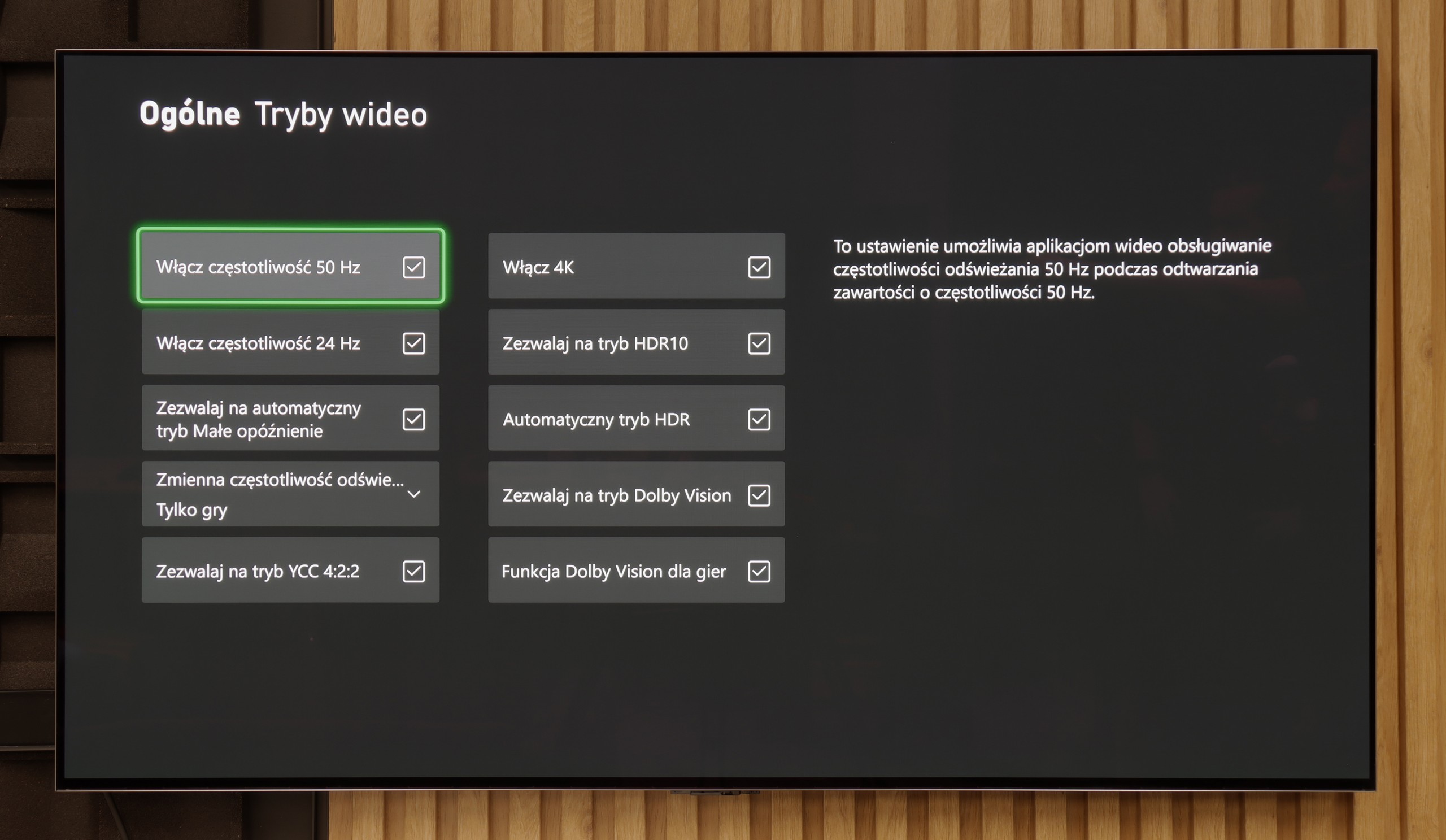

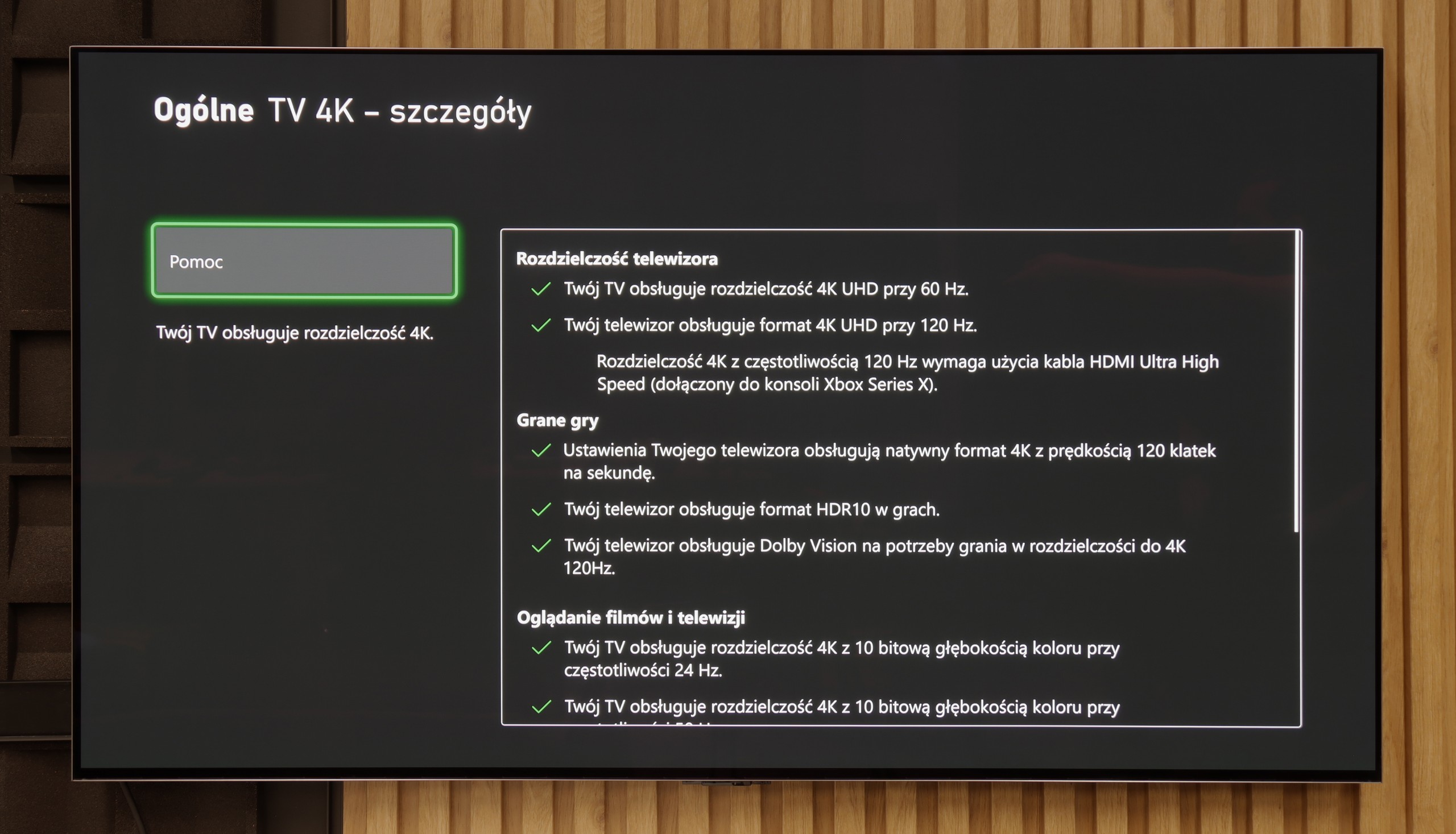

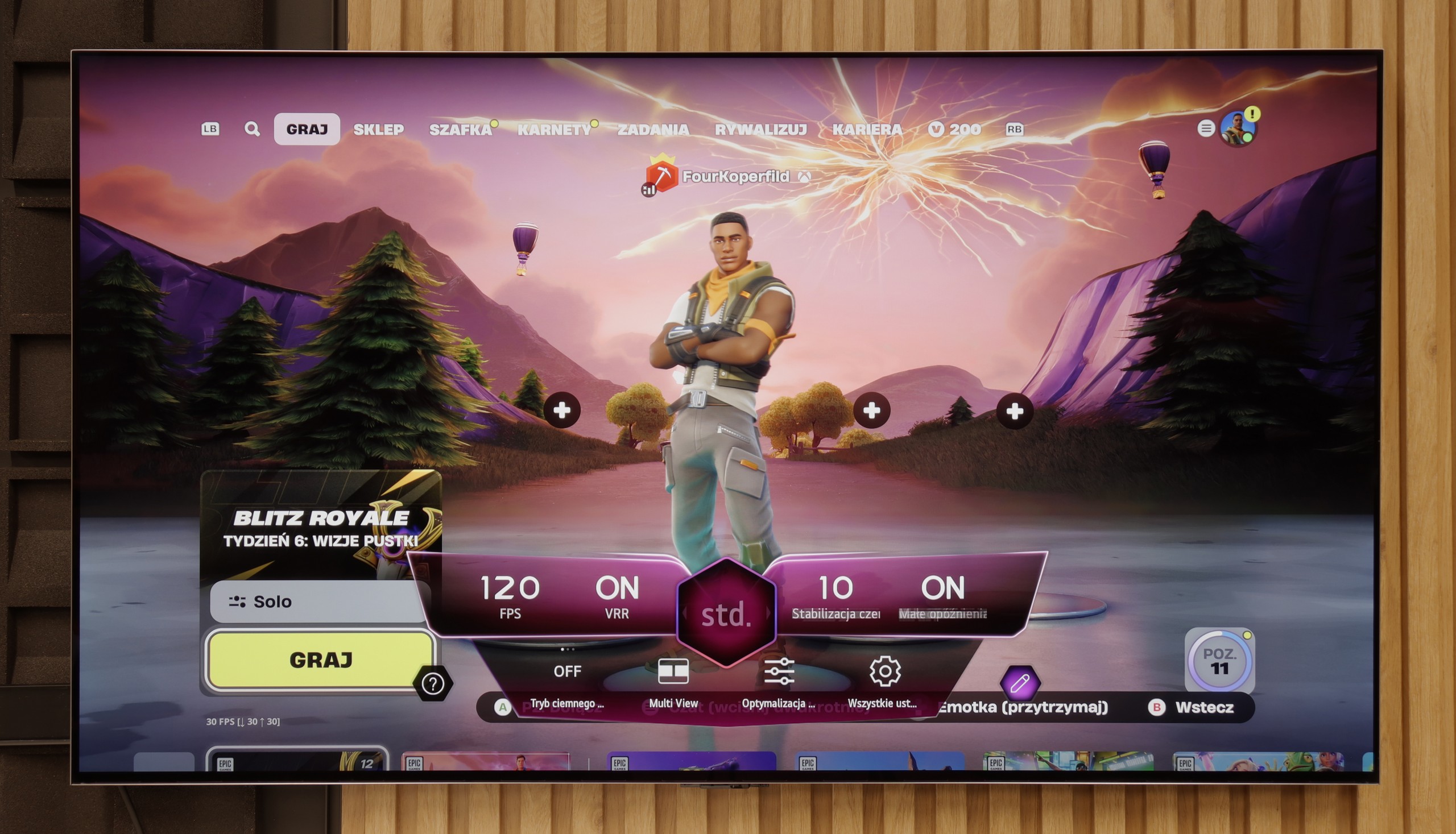

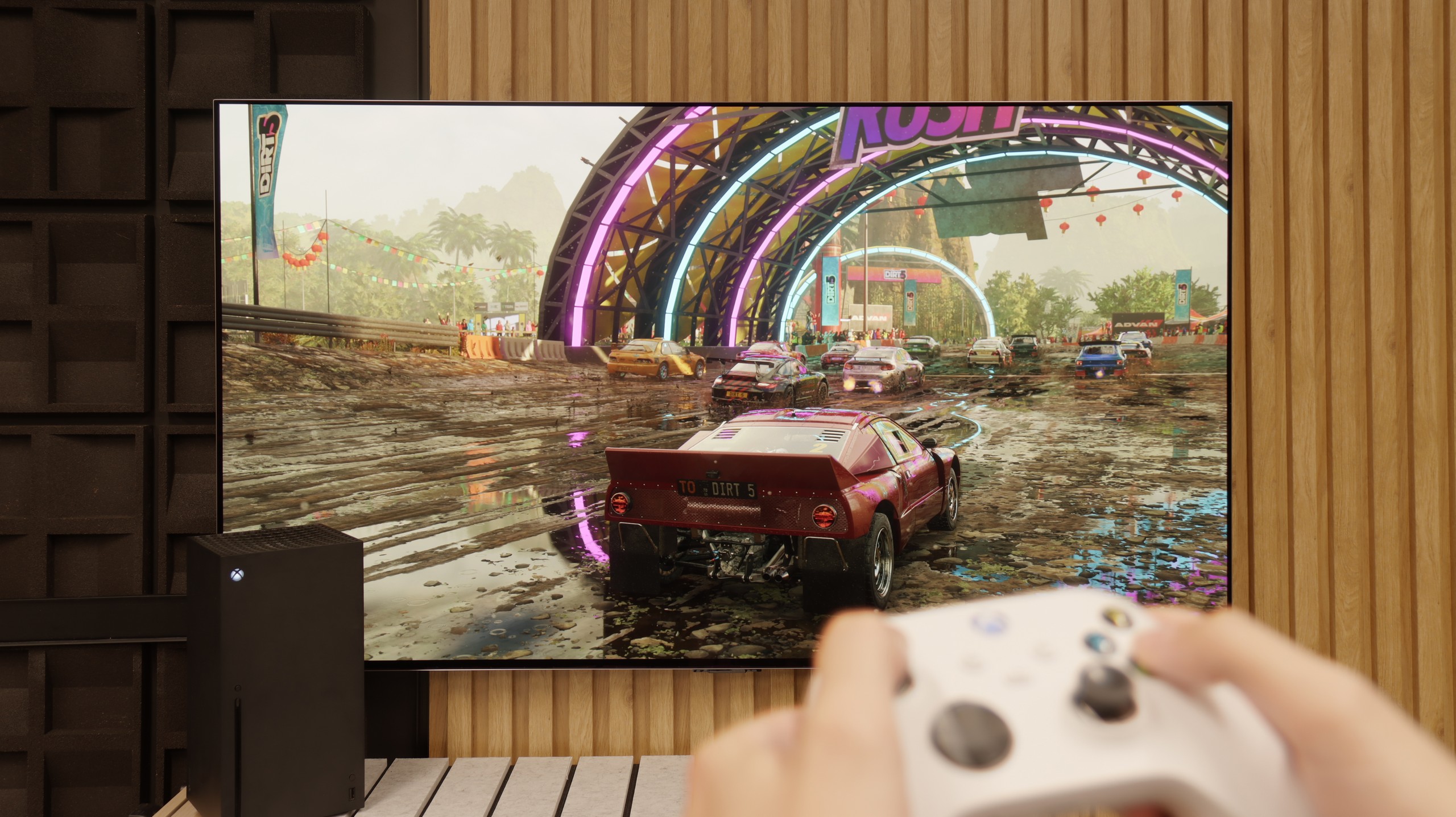
Sony A95L is a television that will truly satisfy gamers, thanks to several key features that set it apart from the competition. First of all, a 120 Hz refresh rate – this is something that anyone who loves fast action games, racing, or dynamic shooters will appreciate. This ensures exceptionally smooth visuals, making gameplay more satisfying without annoying stutters. The A95L Sony also has an ALLM (Auto Low Latency Mode) feature that automatically activates low latency mode when we start up a console. What does this mean? Above all, faster on-screen responses, which is invaluable in games where every second counts. Additionally, there’s VRR (Variable Refresh Rate), which adjusts the refresh rate to match the frame rate generated by the console. The result? No tearing, and everything looks smooth and consistent – even with fluctuating FPS.
It’s worth mentioning the support for Dolby Vision with low input lag in games – something we don’t often encounter in televisions, yet it’s included here. This makes the visuals in HDR-enabled games incredibly vibrant, with rich colors and excellent contrast. Both the brightest and the darkest details are visible, making everything look just as the game developers intended. And let’s not forget the "Game Bar" – a small but very practical feature. It gives us quick access to all the important gaming settings, such as VRR and latency information. There’s no need to interrupt gameplay to adjust settings – everything is at hand.
However, it is important to remember that the A95L offers only two HDMI 2.1 ports with full bandwidth, one of which is designated for eARC. This may pose a limitation if we plan to connect multiple devices – for example, a next-gen console and a soundbar simultaneously. In such cases, the eARC occupying one of those ports may be somewhat troublesome, blocking the ability to connect a second console.
Features for gamers? Perfect. That should be enough for you to know what level we are dealing with here. G5 is a television designed with gamers in mind, so we find literally everything one can expect from a gaming screen. There is Game Bar, support for high resolutions with high refresh rates – that is, 4K at 120 Hz, and even more, because the panel has a refresh rate of 165 Hz (which PC gamers will benefit from). The television supports variable refresh rates (VRR), automatic low latency mode (ALLM), and correctly supports HDR in games thanks to HGiG. All of this adds up to one of the best sets of gaming features available on the market. Well done, LG.
Input lag
9.8/10
9.9/10
SDR
HDR
Dolby Vision
When it comes to input lag, Sony A95L really delivers. Even in Dolby Vision mode, the lag is surprisingly low – results below 10 ms with 120 Hz content are something that makes a huge impression. With such low input lag, gaming is incredibly responsive, and every action in the game is immediately reflected on the screen. For those playing at 60 frames per second, an input lag of 17 ms is also very good. It's a value that practically does not affect the gaming experience – it falls within the so-called "placebo effect." Sony deserves praise for the update to the Dolby Vision Game mode, which resolved the high input lag issue present at the TV's launch in 2023.
The input lag on the LG G5 is incredibly low. The response time to our actions – whether we're playing with a controller, keyboard, or mouse – is almost perfect. The controls are instant, and the game reacts exactly when we expect it to. The Dolby Vision Gaming mode does introduce slightly higher delays, but even then it's hard to complain about anything – in the worst case, the values hover around 20 ms, which for most players will be practically unnoticeable.
Compatibility with PC
5/10
8.8/10

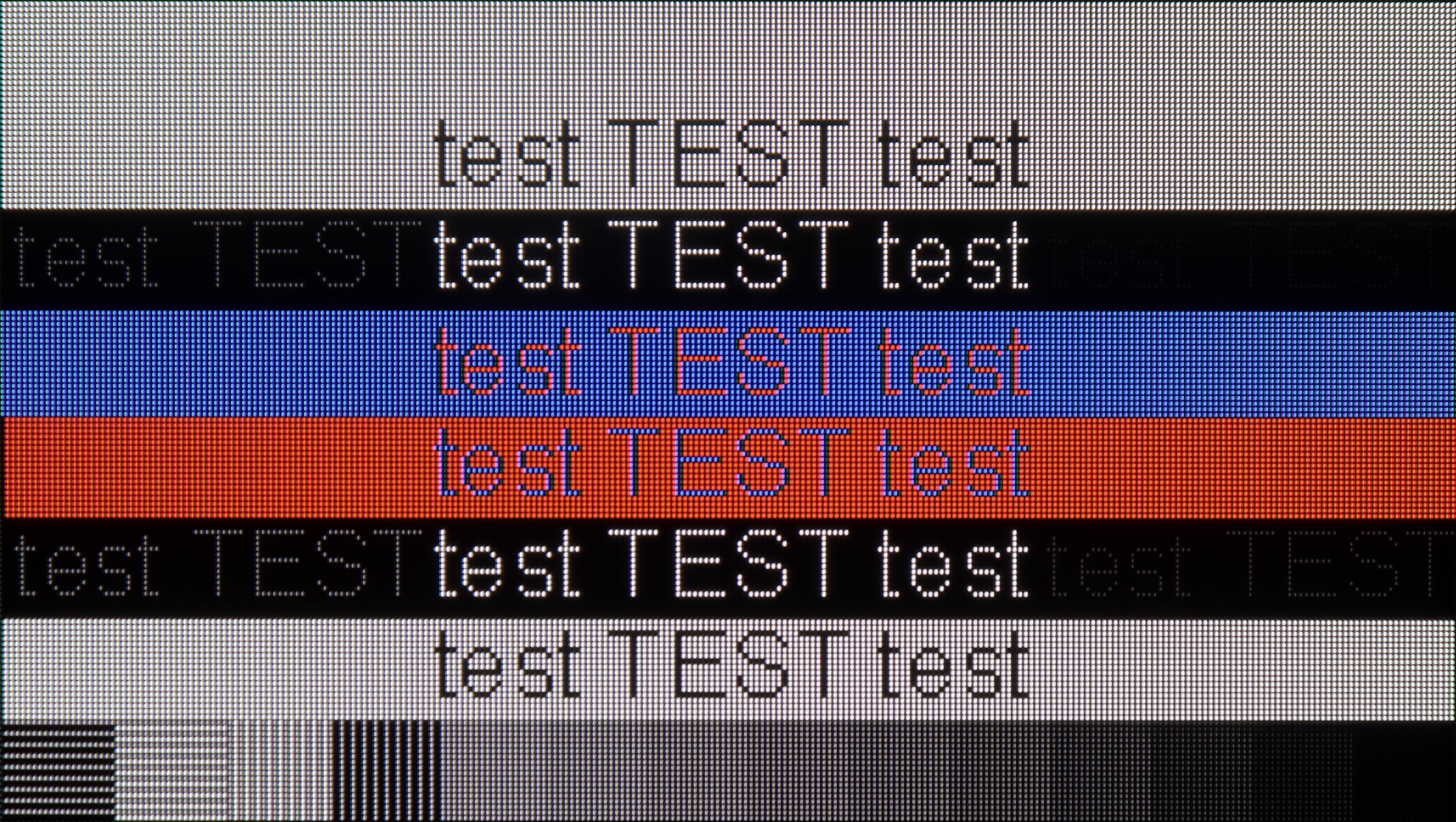
Sony A95L TV offers compatibility with a computer at 4K resolution both at 60 Hz and 120 Hz. In 4K mode at 60 Hz, the readability of fonts is at a good level, making it comfortable to use the TV as a monitor for office work or browsing content.
Unfortunately, when switched to 4K with a refresh rate of 120 Hz, the quality of the displayed text deteriorates – the resolution is reduced by 2 times, negatively affecting the clarity of the fonts. In 4K, fonts lose sharpness, which can make using the TV as a computer monitor at higher refresh rates more challenging over long periods. Of course, the problem disappears when we switch back to 60 Hz, but this can be quite cumbersome when the TV forces us to "juggle" the settings.
Collaboration with a PC? Almost ideal. The television, as we mentioned earlier, has great features for gamers – including those using a PC. On board, we find full G-Sync certification, a 165 Hz panel, and a super-fast input lag of around 5 ms. Thanks to the correct implementation of chroma 4:4:4, fonts are very readable – both the smallest and the largest. Although due to the WRGB subpixel layout, there may be slight shadows around the characters, for most users this effect will be virtually unnoticeable. The G5 performs excellently as a screen for work, entertainment, and gaming – also from a computer.
Viewing angles
9.7/10
7.5/10
The viewing angles on the Sony A95L are among the best on the market, thanks to the QD-OLED matrix. With this technology, colors remain vibrant, and the contrast hardly changes regardless of the viewing angle. This is a result that even regular OLED panels do not achieve, which makes the A95L perfect for rooms where viewers change positions or where there is a larger group of spectators.
The viewing angles on the LG G5 are very good, mainly due to the use of the WOLED matrix. It's hard to find something to complain about here – the image does not significantly lose brightness or quality even when we look at the screen from the side. However, it must be fairly noted that there is some regression compared to the G4 model. The predecessor used an MLA matrix with micro-lenses, which offered slightly better light distribution. Also, compared to QD-OLED matrices, the angles are worse. Nevertheless, the overall viewing experience at an angle remains very good and should not be an issue in everyday use.
TV efficiency during daytime
5.4/10
8/10

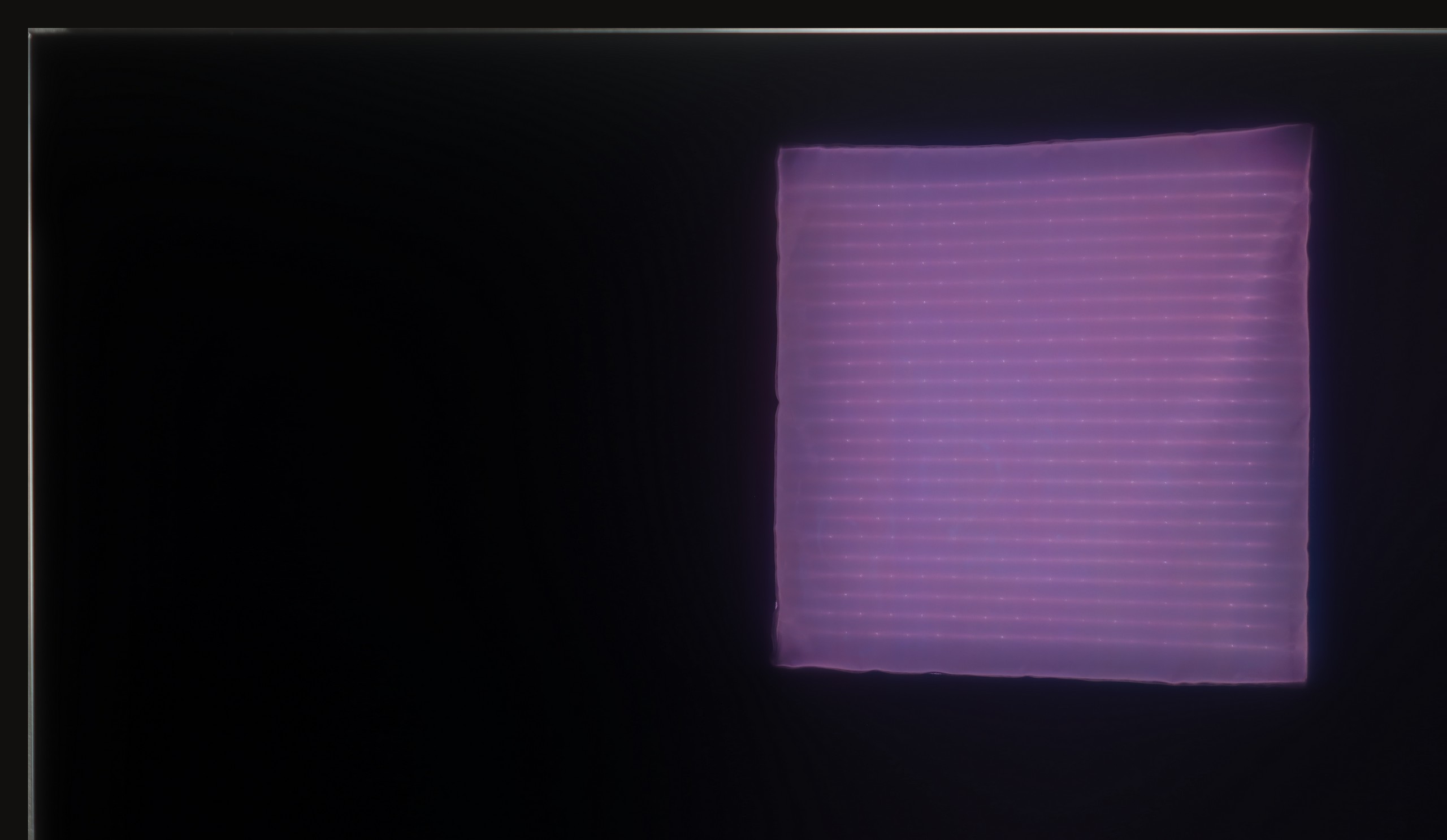


Matrix brightness
Average luminance SDR
LG OLED G5: 810 cd/m2
Sony A95L: 387 cd/m2
Sony A95L performs quite well in daylight conditions. The QD-OLED panel effectively suppresses reflections and glare, making viewing comfortable even in bright sunlight. An average brightness of 380 cd/m² is a really good result, especially for an OLED TV – it holds its own, although it still cannot compete with Mini LEDs, which are unbeatable in this regard. One of the issues that may bother some viewers is the characteristic QD-OLED effect, where black loses its depth and takes on a slight cherry tint in strong light.
The LG G5, thanks to its very high brightness, performs excellently in bright rooms. Even with SDR content, the average brightness value is around 800 nits, which is significantly more than in standard televisions. It can easily handle a bright living room. Although the panel averages out reflections, it still maintains significantly better black levels and colors during the day than QD-OLED panels or matte-coated screens. The G5 will perform well in very sunny rooms—unless you really can't stand reflections on the screen. In that case, you will need to use blackout shades or consider buying a television with a matte screen.
Details about the matrix
Subpixel Structure:

Panel uniformity and thermal imaging:


TV features
8.8/10
8.5/10
- HDMI inputs2 x HDMI 2.0, 2 x HDMI 2.1 48Gbps0 x HDMI 2.0, 4 x HDMI 2.1 48Gbps
- Other inputsIR (remote)
- OutputsToslink (Optical audio), eARC (HDMI), ARC (HDMI)Toslink (Optical audio), eARC (HDMI), ARC (HDMI)
- Network InterfacesWi-Fi 2.4GHz, Wi-Fi 5GHz, Ethernet (LAN) 100MbpsWi-Fi 2.4GHz, Wi-Fi 5GHz, Ethernet (LAN) 100Mbps
- TV receptionDVB-T, DVB-T2, DVB-S, DVB-S2, DVB-CDVB-T, DVB-T2, DVB-S, DVB-S2, DVB-C
Classic features:
- Recording to USB (terrestrial TV)
- Recording programming
- Picture in Picture (PiP)
- RF remote control (no need to aim at the screen)
- Backlit remote control
- Teletext
- Audio only mode
- Bluetooth headphones support
- Simultaneous Bluetooth headphones & TV audio
Smart features:
- AirPlay
- Screen mirroring (Windows Miracast)
- Voice search
- Voice search in native language
- Ability to connect a keyboard and mouse


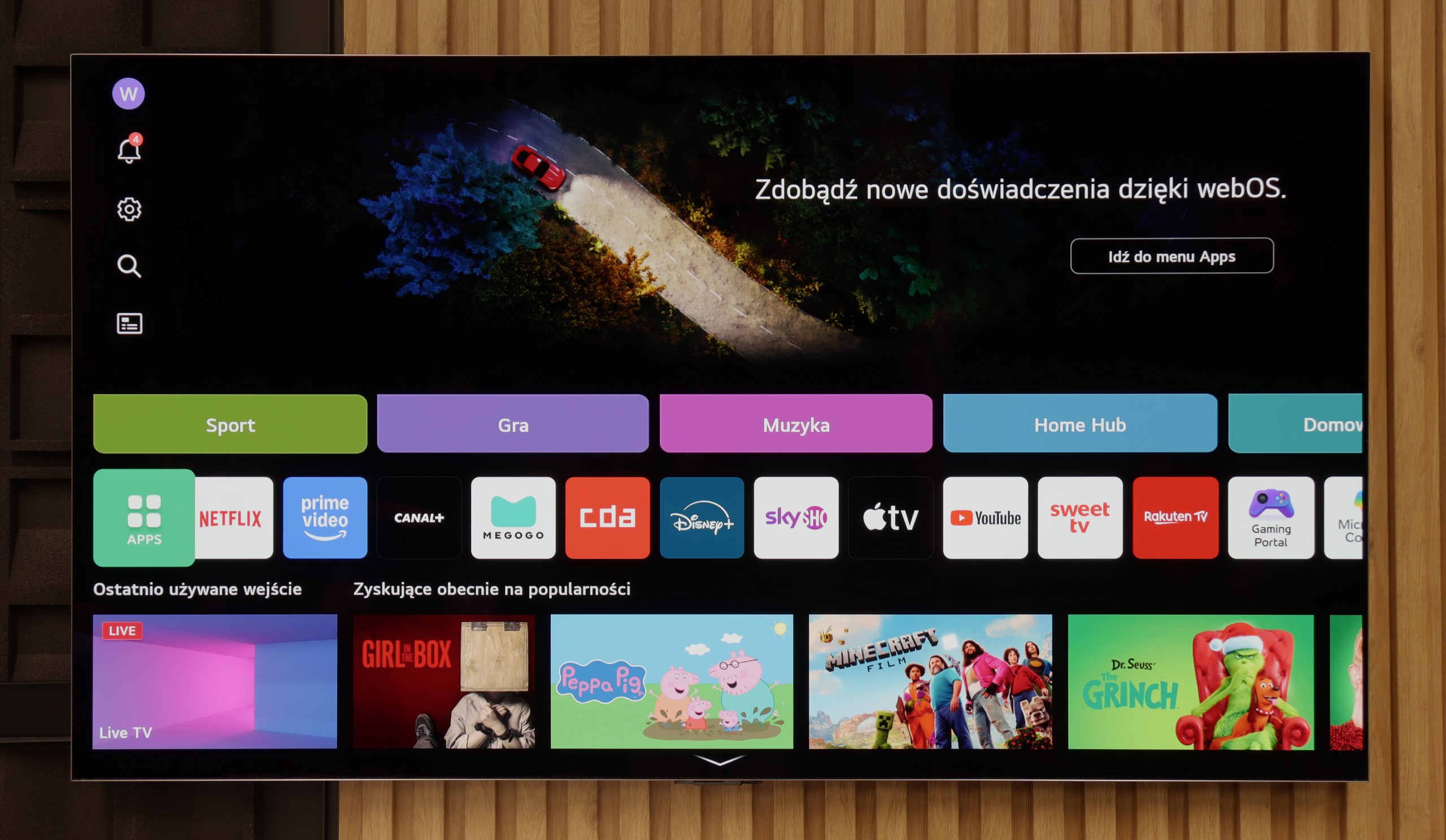
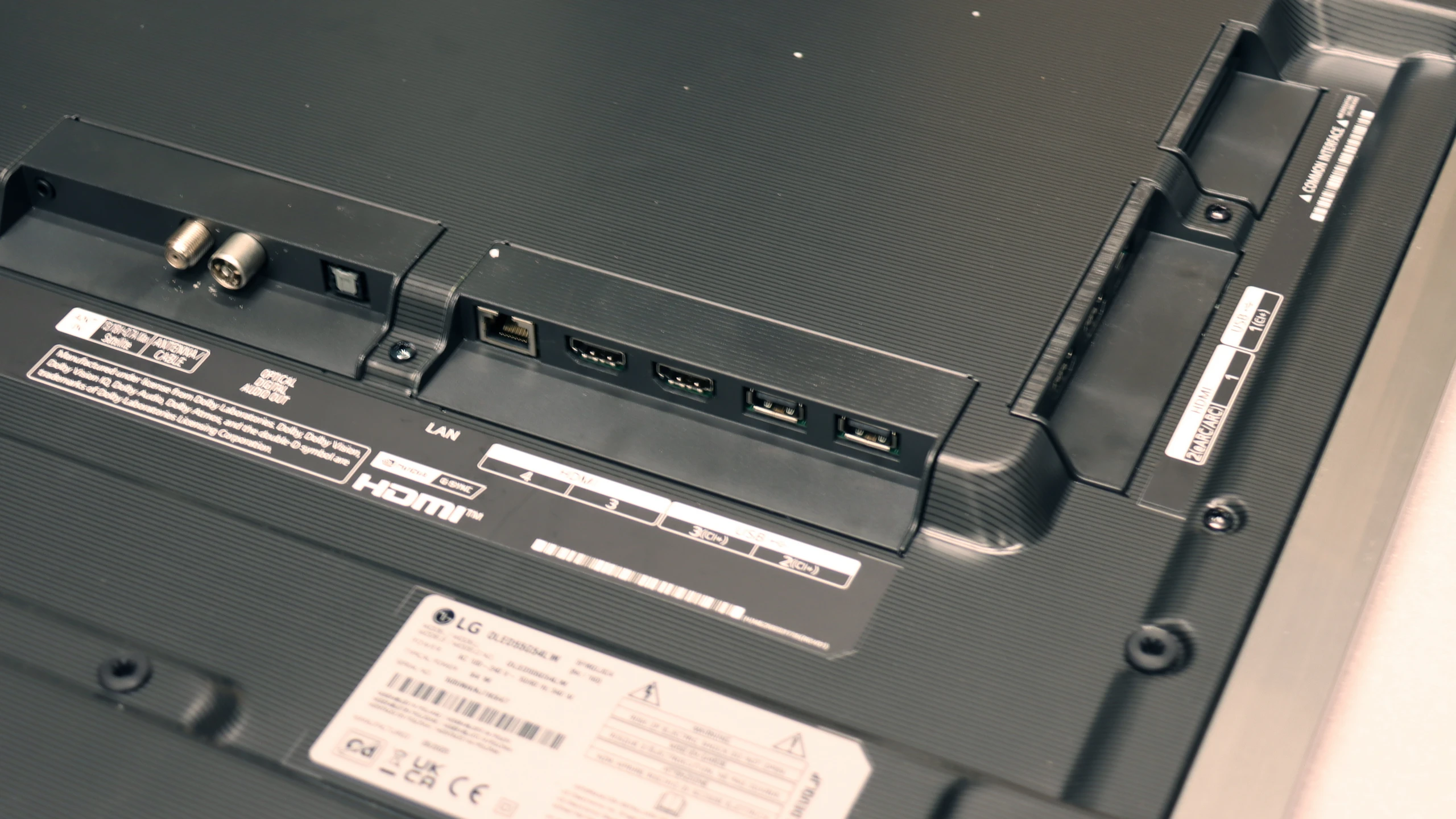
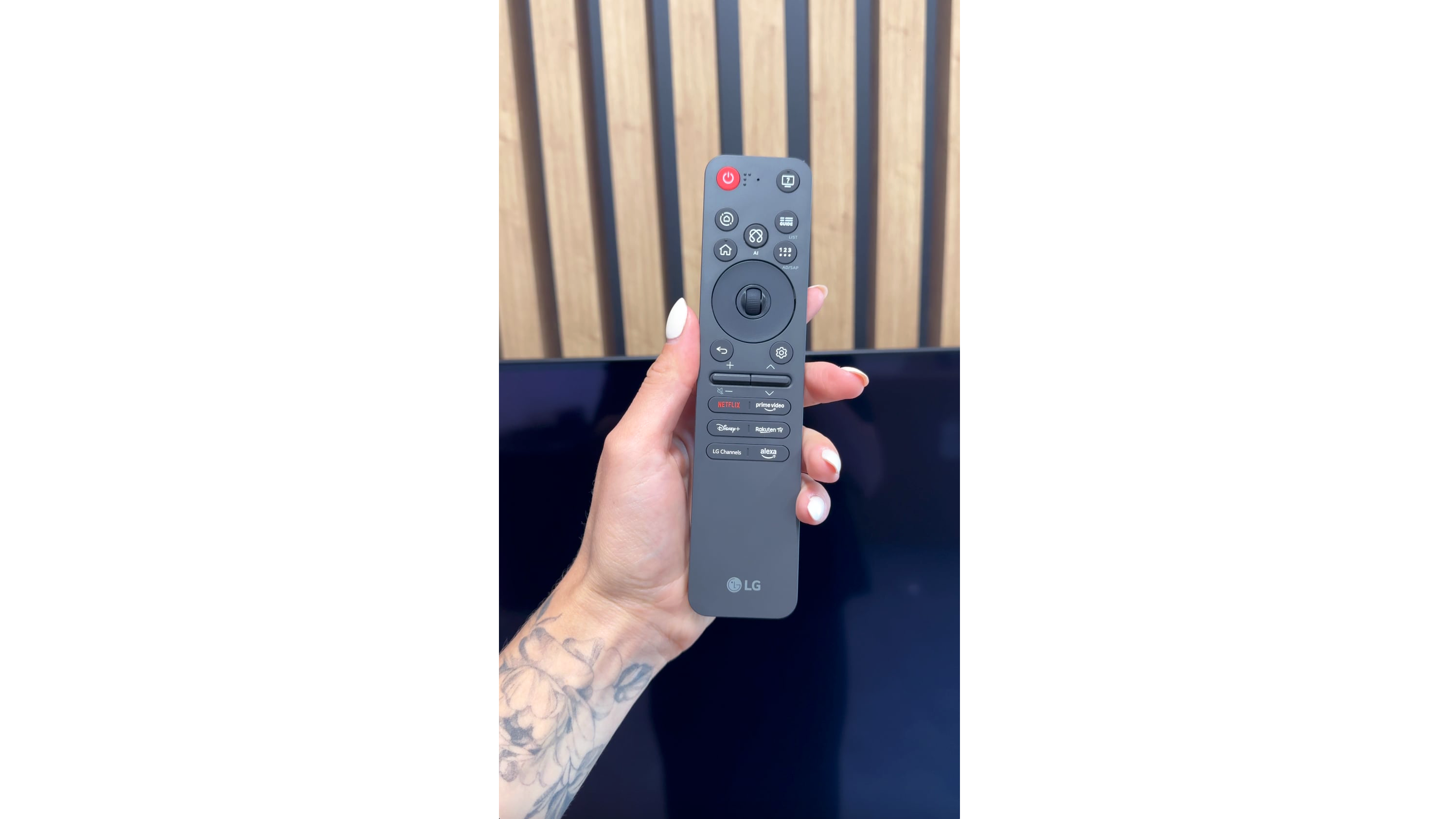
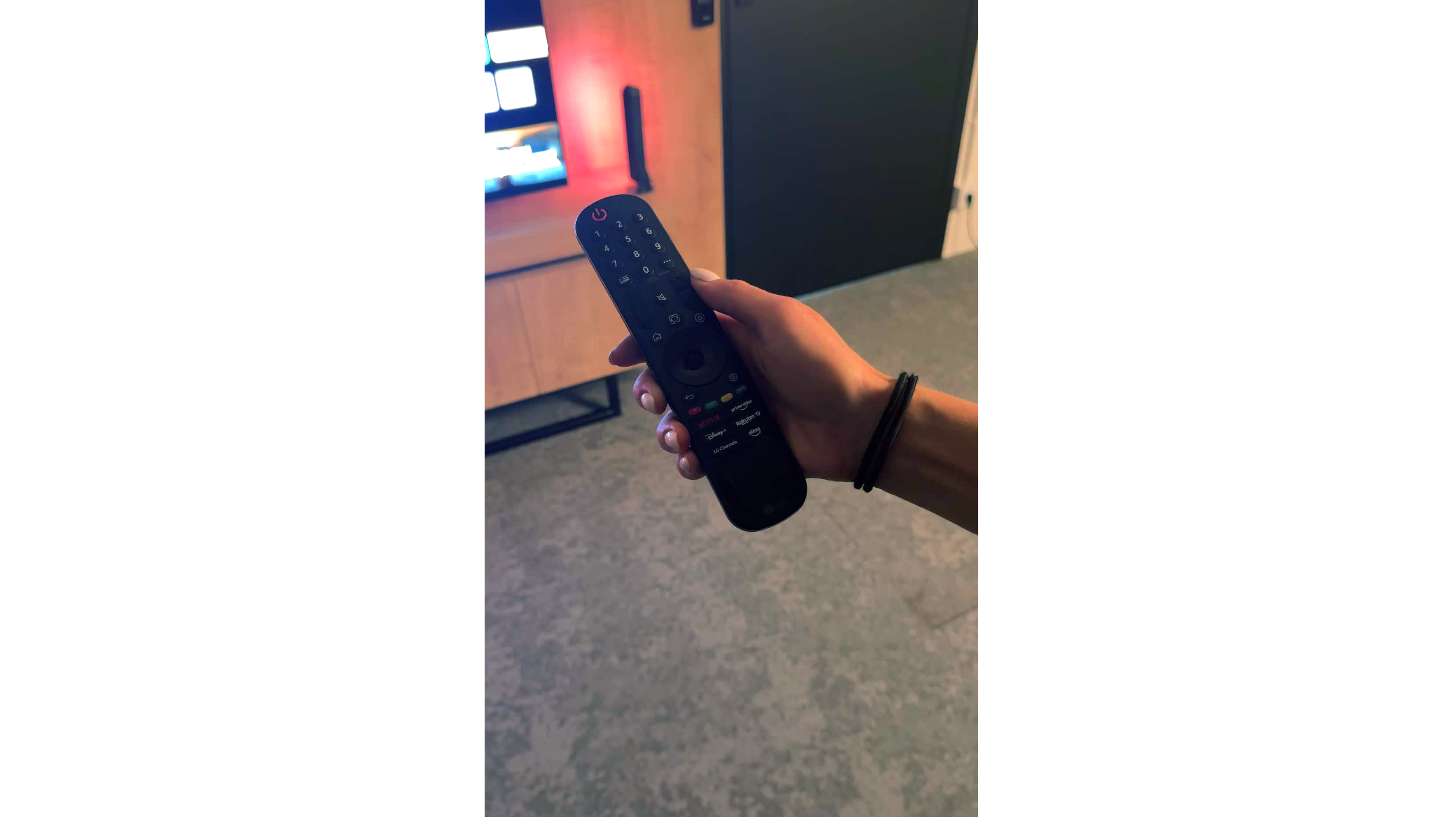
Sony A95L operates on the Google TV operating system, which means easy access to a wide range of applications, streaming services, and various personalization features. The interface is clear and easy to navigate, and the wealth of available applications ensures that everyone will find something for themselves – from popular streaming services like Netflix, Disney+, and HBO Max, to various music and sports apps. Google TV also supports a voice assistant, allowing you to easily search for content, control TV settings, and even manage other smart devices in the home – all with simple voice commands.
Sony A95L also offers a range of practical features that make it even more versatile. The TV has the ability to record programs directly to USB memory, providing a convenient solution if you can't watch something live. It also supports AirPlay, making it easy to stream content from Apple devices, and additionally, various peripherals such as headphones or game controllers can be connected via Bluetooth. The package includes two remotes – one traditional and a modern, backlit one, which is particularly useful during evening viewing when the room is dark. It is worth mentioning the lack of the PIP feature, which allows watching multiple TV signals simultaneously.
As for the appearance, A95L Sony may not be the thinnest OLED TV on the market, but it has its advantages. The package includes a practical stand that can be adjusted in various ways, allowing you to tailor the TV to your needs and space arrangement. Additionally, the manufacturer included the Bravia Cam, which opens up additional possibilities – from video calls to intelligent features, such as optimizing picture and sound based on the viewer's position. Although it is not the slimmest, its solid construction and useful accessories make the A95L look really good in any living room.
Classic Features
LG G5 has a lot to offer when it comes to classic TV features. Aside from the lack of the ability to watch two sources (PIP), the television performs well for everyday use. There are no issues with connecting external Bluetooth devices, such as headphones, and the EPG interface is very clear and understandable – even for those who are not particularly tech-savvy.
Smart TV Features
The Smart TV in the G5 operates on the WebOS system – it is the heart and brain of the entire television. Thanks to the Magic remote, using the G5 is truly enjoyable. We control the cursor on the screen with wrist movements, which is somewhat reminiscent of using a mouse in the air. The system itself is very comprehensive and offers everything one could expect: AirPlay, screen mirroring, voice search, and voice commands – all of these work smoothly and without delays. Without a doubt, this is one of the best operating systems in televisions on the market.
Note:
During our testing, we had practically nothing to complain about – except for one exception: the confusion surrounding the remote. Depending on the market and the specific version of the model, you may come across the new, minimalist Magic remote (without a numeric keypad), or the older version with a full set of buttons. We tested the G54LW model, which had the new Magic remote, but it is hard to say how the situation looks in other variants. Perhaps it is a similar situation to the LG C5 series, where the addition of the remote also depends on the specific market.
Playing files from USB
8.7/10
9/10
Supported photo formats:
Maximum photo resolution:

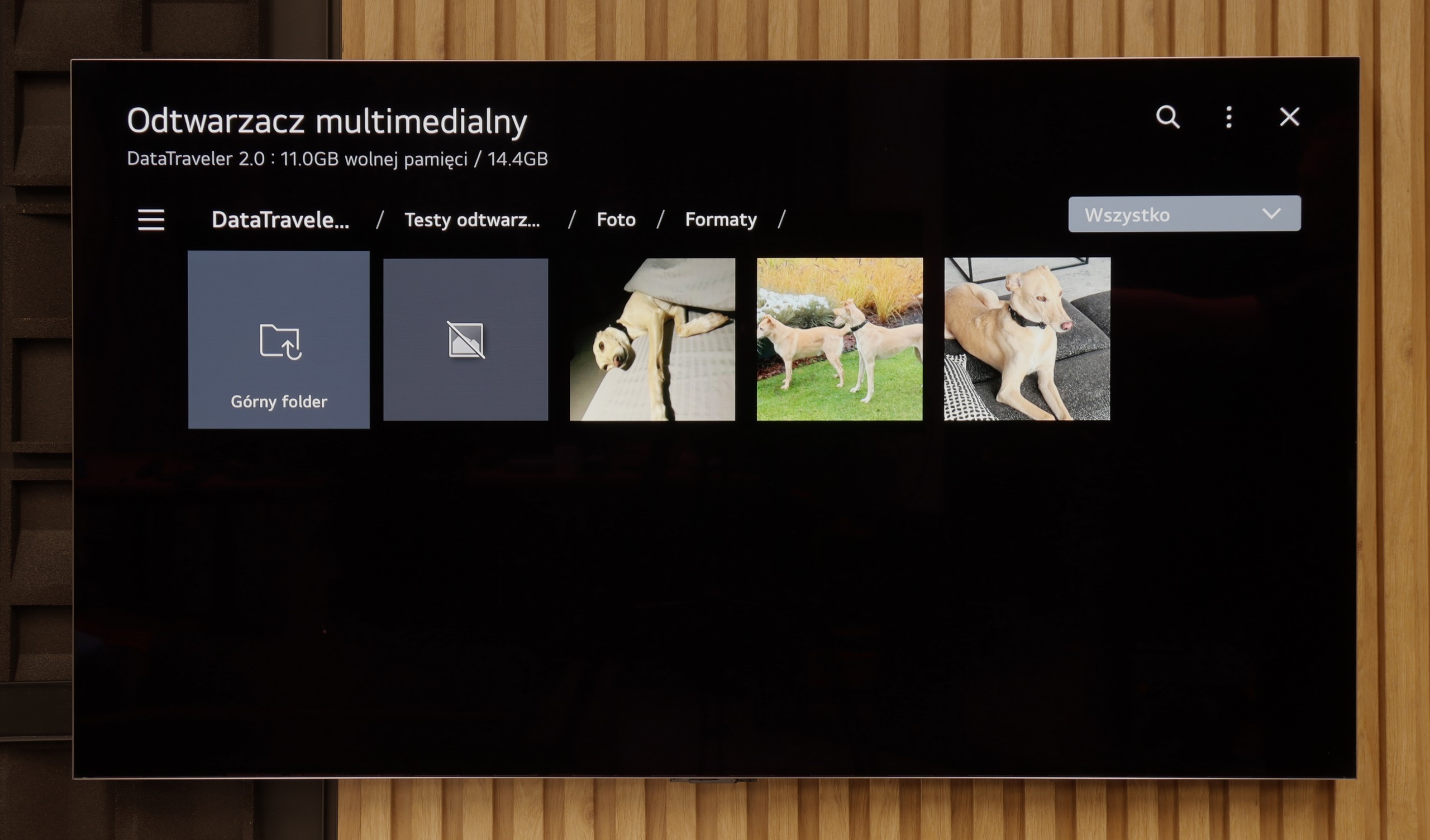
Sony A95L performs quite well when it comes to playing files from USB. The built-in media player will satisfy most users – it is easy to use and supports popular formats, allowing for easy playback of videos, photos, or music directly from the connected flash drive. The only thing missing is the ability to change the font color in subtitles, which can be problematic in some situations. Fortunately, the Google TV system allows for the installation of other media players that offer more advanced customization options, so you can easily adjust everything to your needs.
The built-in media player in the LG G5 is really very good. It supports virtually everything you would expect from a modern television – most popular formats work without issue, and the application performs quickly. Our only disappointment was the lack of support for very high bitrate HEVC files at 85 Mbit/s – similar to the C5 and B5 models. Interestingly, the same file worked flawlessly on last year's LG OLEDs, so it's hard to say what is behind this change. Nevertheless, in everyday use, the G5 will handle the vast majority of content, and there will be no need to connect any external devices for media playback.
Apps
9.6/10
9.1/10














































Sound
7.9/10
8.7/10
- Maximum volume--
- Dolby Digital Plus 7.1
- Dolby True HD 7.1
- Dolby Atmos in Dolby Digital Plus (JOC)
- Dolby Atmos in Dolby True HD
- DTS:X in DTS-HD MA
- DTS-HD Master Audio
Sony A95L offers sound that definitely stands out among most televisions. Considering the built-in speakers, the audio is truly impressive – full, with well-balanced low and mid tones. The dialogues are clear, and the sound effects are well distributed, making the television great for both watching movies and gaming. The Acoustic Surface Audio+ system, which converts the screen's vibrations into sound, creates a more spatial impression, adding additional depth to the viewed material.
The sound on the LG G5, given its slim body, is truly phenomenal. When listening to music, a light, pleasant bass can be felt, and in movies, the dialogues are clear and easily heard – they do not get lost even in dynamic scenes. Unfortunately, a certain disappointment is the lack of support for the DTS format, which LG used in its older models. It's a shame, because many people with home theaters may see this as a step backward.


